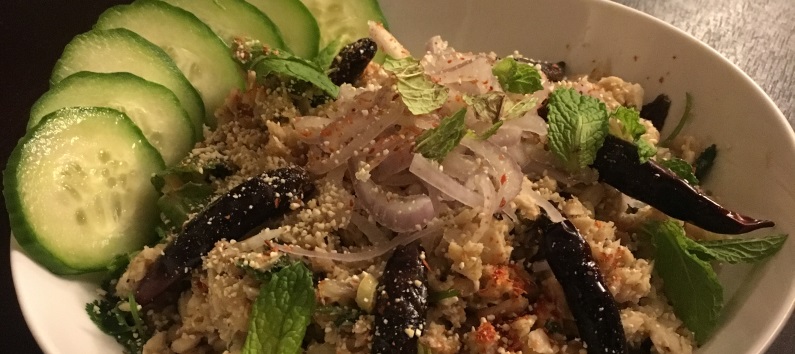
Laap, or more popularly known as larb, is a versatile and delicious dish from Laos and Northern Thailand. The term laap is derived from the Kra-Dai language root for "to mince" or "to chop." Knowing this is key to understanding the dish. Laap, regardless of its particular iteration, depends on minced protein to function as its base. Beyond that, the seasonings, cooking method and final plating are dependent on the flavors of the region.
Laap typifies cuisine in the region of Isan, which is a former region of 20 provinces in Thailand and Laos that is united through language, culture and cuisine.
In the Laotian/Isan version, minced meat is cooked in a light amount of stock in order to prevent browning and sticking. It is then seasoned with dried chili powder and served with roasted rice (known as khao kua), fresh herbs like mint, lime juice, fish sauce, shallots, garlic and galangal (a root spice from one of four related aromatic rhizome species). The result is a dish layered with intense flavors, textures and aromas.
The fish sauce commonly used in Laos is known as padek and possesses more body and a milder flavor than Thai or Vietnamese fish sauces. The intensity of the seasoning pairs better with the staple of the Laotian diet: sticky rice. Sticky rice (khao niao) is also known as glutinous rice or sweet rice (which is what it is typically called in American Asian markets). This particular variety of rice is the traditional starch in Northern and Northeastern Thailand, as well as in Laos, and tempers the fiery intensity of the laap.
The Northern Thai version of laap comes from the Lanna Kingdom, which existed in the north of Thailand and eastern Myanmar between the thirteenth and eighteenth century. This version relies heavily on dried spices like cumin, cinnamon, long pepper and cardamom for its flavor and does not use fish sauce or a souring agent. Other differences include the frequent additions of bile, blood and offal. The Lanna style was highly influenced by the region's location along the old Silk Road; The Lanna Kingdom was a way-point for traders bringing spices from India to the markets of China.
Both laap versions can be served raw (known as laap dip in Thai and Laotian) and are still prepared this way today. Laap is also related to other minced meat dishes in Laos and Thailand like luu (raw minced meat seasoned with blood and lemongrass) and koi (a ceviche-style dish made with river mussels or snails). The easy preparation and affordability of the ingredients makes these dishes popular in the Isan region.
Included below is a version of laap known as laap plaa (fish laap). This dish is a Laotian-style laap and exhibits the classic flavors of lime, fish sauce and fresh herbs. Most, if not all, of the ingredients needed can be found at Southeast Asian Markets like World Foods in City Heights, Muang Lao Market (at 47th & Market) and Thuan Phat in Linda Vista.
Ingredients:
Garlic-Galangal paste:
- 4 cloves garlic
- 2-inch piece of galangal, peeled and chopped
Dressing:
- 1 tablespoon (or to taste) of Thai chili powder, or cayenne pepper
- 3 tablespoons fish sauce
- 2 tablespoons lime juice
- 1 teaspoon palm sugar or brown sugar
Laap:
- 1 pound of fillet of catfish or a white fish like mahi-mahi
- 1 cup chopped, mixed herbs like Thai Sweet Basil (bai horapa), Vietnamese coriander (rau ram*), green onion (scallions), cilantro/coriander leaves (pak chee*)
- 2 tablespoons toasted rice powder (see prep directions below)
- ¼ cup chopped mint leaves, lightly packed
- 2 medium sized shallots, sliced and soaked in cold water for 10 minutes
*Although rau ram and pak chee are translated as coriander leaves, they are different herbs.
Preparation:
For the paste:
- Roast the garlic and galangal over the burner of a gas stove, or in a broiler on low until slightly charred. (This will enhance the aroma and taste.)
- Grind or pound (with mortar and pestle) the galangal, garlic and a pinch of salt into a smooth paste. Set aside.
For the laap:
- Stirring constantly, toast 1 cup of uncooked sticky rice in a dry skillet on medium-high until aromatic and golden brown (10-15 minutes).
- Pound or grind the toasted rice into a course powder.*
- Cook the fish fillet in a skillet over medium heat, flipping once, until just cooked through, about 5-7 minutes depending on thickness.
- On a cutting board, chop the fish into uniform pieces, trying to maintain the integrity of the flesh.
- In a small bowl, whisk the fish sauce, chili powder, lime juice and sugar together until the sugar is fully dissolved.
- In a large bowl, thoroughly combine the fish, garlic-galangal paste, drained shallots, chopped herbs and fish sauce/lime dressing.
- Transfer the dish to a serving platter and sprinkle with the roasted rice powder and chopped mint leaves.
- Serve with sliced cucumber, raw green cabbage leaves and sticky rice.
*As the recipe only calls for 2 tablespoons of toasted rice powder, you can store the remaining powder in an airtight container for future use.
Recipe and photos by Liam Fox








